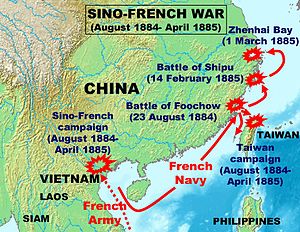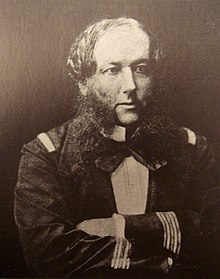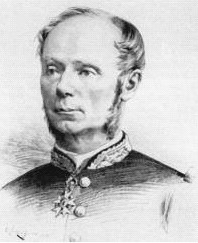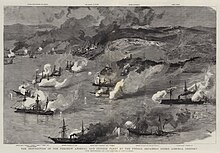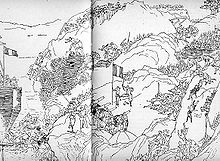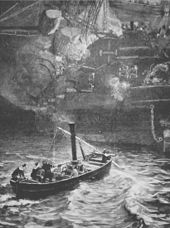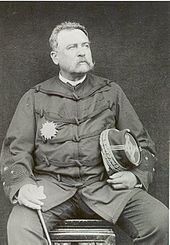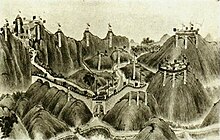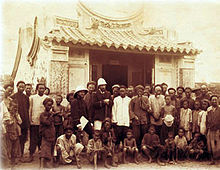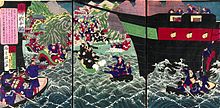Sino-French War
| date | August 1884 to April 1885 |
|---|---|
| place | Tonkin , Southeast China and Taiwan |
| Casus Belli | Supremacy in Tonkin |
| output | French victory |
| Territorial changes | Annam and Tonkin |
| consequences | France establishes a protectorate over Annam and Tonkin. |
| Peace treaty | Treaty of Tientsin |
| Parties to the conflict | |
|---|---|
| Commander | |
|
|
|
| Troop strength | |
| a total of about 15,000 to 20,000 soldiers | a total of about 20,000 to 35,000 soldiers |
| losses | |
|
2,100 dead and wounded |
over 10,000 dead and wounded |
Fuzhou - Keelung - Tamsui - Kep - Tuyen Quang - Yu Oc - Nui Bop - Shipu - Lang Son - Dong Dang - Zhenhai - Hoa Moc - Phu Lam Tao - Bang Bo - Pescadoren
The Sino-French War ( Chinese 中法 戰争 , Pinyin pinyin: Zhōng fǎ Zhànzhēng ; French Guerre franco-chinoise ; vie. Chiến tranh Pháp-Thanh ) was a war between the Chinese Empire of the Qing Dynasty and the Third French Republic . It was fought between August 1884 and April 1885 in the Tonkin area , Taiwan and along the southeast coast of China. Since the French achieved their original war aims, the war is generally viewed as a French victory. However, since the Chinese were able to achieve some victories on the battlefield and fared better than in previous wars against foreign powers, the war there is often understood as a draw or even a Chinese victory.
background
France had a fundamental interest in what is now Vietnam since the late 18th century. At that time, the French missionary Pigneau de Béhaine began to recruit French volunteers who were supposed to help Gia Long to the throne of Vietnam, where he later founded the Nguyn dynasty . With Gia's support, Pigneau hoped to gain privileges for the Catholic missionaries and for France.
In 1858 France led an expedition to Vietnam for the first time and in 1862 annexed several provinces in the south of the country, from which they formed the colony of Cochinchina in 1864 . This laid the foundation for what would later become French Indochina . Soon after, French explorers began to sail the Red River and advance through northern Vietnam to its headwaters to Yunnan . They hoped that a trade with inner China could be established over this river, which would bypass the treaty ports approved by China. However, this was prevented by the Black Flags , a Chinese bandit group under Liu Yongfu , which had established itself in North Vietnam from 1865. These controlled the course of the river between Sơn Tây and Lào Cai and let French traders pass, if at all, only under very high road tariffs, which made any trade unprofitable.
Henri Rivieres expedition to Tonkin
Over time, the Vietnamese repeatedly complained about the activities and behavior of French traders in the country, which is why in 1881 a small French force under Henri Rivière was sent to Hanoi to investigate the incidents. Since there was resistance to the presence of French troops in Hanoi, Rivière was on April 25, 1882 disregard otherwise commands from Paris , the citadel of Hanoi storm. Although the French withdrew immediately afterwards and returned control of the citadel to the Vietnamese, they were just as alarmed by Rivière's aggressive action as their protecting power, China.
The Vietnamese government, whose own poorly equipped and trained army was unable to offer effective resistance to the French, turned to the black flags of Liu Yongfu. Its troops had already inflicted a defeat on a French armed forces in December 1873, killing their commander Francis Garnier . Like Rivière, Garnier had disobeyed his orders and planned an unauthorized intervention in northern Vietnam. The Vietnamese, who had recently suffered a series of defeats against the French troops, called on Liu for help, who was able to achieve a victory in the immediate vicinity of Hanoi. In response to this defeat, the French government subsequently condemned Garnier's arbitrary actions.
At the same time, the government in Hanoi also asked the Chinese for help. Since Vietnam had long been a vassal state of China, the latter agreed to equip the troops of the black flags and to take political action against the French actions in Tonkin. This included the threat that China could not tolerate French control of Tonkin. In the summer of 1882, troops from the Chinese Guangxi and Yunnan armies also crossed the border and occupied the places Lạng Sơn , Bắc Ninh and Hung Hoa , among others . The French ambassador to China, Frédéric Burée, assessed the danger of war with China so high that he negotiated a contract with Li Hongzhang in November and December 1882 , in which Tonkin was divided into a Chinese and a French sphere of interest. The Vietnamese were not informed about the negotiations and were surprised by the conclusion of the contract.
Rivière turned down the contract between Bourée and Li and decided in early 1883 to ignore it. Shortly before, he had been reinforced by a battalion of marines from France, which is why he believed himself strong enough to be able to advance beyond Hanoi. On March 27, 1883, he and 520 soldiers captured the fortress of Nam Dinh under the pretext of wanting to secure the communication routes between Hanoi and the coast . In response to this, the Vietnamese and Black Flag troops attacked the French who had stayed near Hanoi on the following day and were repulsed by the French commander Berthe de Villers in the battle of Gia Cuc .
Rivière, who had been convinced that he would at least be recalled from his post for his illegal action against Nam Dinh, suddenly found himself facing great public popularity in France through the victory at Gia Cuc and was also supported by a change of policy in Paris . The new government under Jules Ferry , in contrast to its previous government, relied more on colonial expansion and therefore decided to support Rivière. Ferry had the contract with the Chinese canceled and ordered Bourée back to France. He also made it clear to the Chinese government that France would place Tonkin under its protectorate. When it became clear to him that the Vietnamese would not be able to defend themselves, they sent further troops under Tang Jingsong to Vietnam in April 1883 to fight together with the black flags against the troops of Rivières.
On May 10, 1883, Liu Yongfu had an oversized invitation to the French posted on the city walls of Hanoi to present themselves to battle. This was followed by the Battle of the Paper Bridge on May 19 , in which Rivière suffered a heavy defeat. With around 450 soldiers, he attacked a strong Black Flag defense position near the village of Cầu Giấy, a few kilometers west of Hanoi. This position was known to the French as the paper bridge (Pont de Papier). After initially looking like the Black Flags couldn't withstand the French onslaught, they later managed to break through on both wings. The French found it difficult to regroup and retreat to Hanoi, especially since several other officers were killed in the course of the battle alongside Rivière and Berthe de Villers.
French intervention in Tonkin
Rivière's death led to aggressive reactions in Paris. Reinforcements were rushed to Tonkin to stabilize the situation and fend off a feared attack on Hanoi.
French protectorate over Tonkin
On August 20, 1883, Admiral Amédée-Anatole Courbet , who had recently been appointed commander of the newly established Tonkin Coastal Division, stormed the fortifications protecting the Vietnamese capital Hu. At the Battle of Thuan An . Then he forced the Vietnamese government to sign the Treaty of Huế , which Tonkin placed under French protectorate.
At the same time, the new commander of the Tonkin Expeditionary Force attacked the Black Flag positions on the Sông Đáy River . Although the French won the Battle of Phu Hoai on August 15th and the Battle of Palan on September 1st, they could not capture all positions of the black flags, which is why both battles were considered French defeats by the world public. General Bouët, who was blamed for missing the targets, drew the consequences and resigned from office in September 1883. Immediately after the fighting, however, there was severe flooding on the Sông Đáy, which is why Liu Yongfu had to vacate his positions and retreat to Sơn Tây .
Confrontation between France and China
For the end of 1883, the French were preparing a major offensive to crush the Black Flag troops and get China to stop aid to Liu Yongfu. At the same time they tried to get other European powers to support this offensive. Sino-French talks in Shanghai between Li Hongzhang and the new French envoy Arthur Tricou had previously been suspended in July after the Chinese envoy in Paris, Zeng Jize , announced that France would not dare a general war with China. The negotiations in Paris continued through the summer and autumn, but ultimately also broke off. The Chinese refused to withdraw their troops from Tonkin, even if doing so would result in an open confrontation with the French troops. As war with China became more and more likely, Paris tried to get the German government to delay delivery of the two German-built Chinese battleships Dingyuan and Zhenyuan . Meanwhile, the French troops expanded their positions in the Red River Delta and set up posts in Quang Yen , Hưng Yên and Ninh Bình .
The rising tensions between France and China led to a series of protests against foreigners in the latter in the autumn of 1883, which were mainly concentrated in the province of Guangdong . In response, various European powers, including France, sent gunboats to Guangzhou to protect their citizens.
Son Tay and Bac Ninh
France was aware that another attack on Liu Yongfu could result in an undeclared war with China. However, since it expected that a quick French victory in Tonkin would induce China to accept the fait accompli , it was ready to take that risk. The command of the Tonkin operations was given to Admiral Courbet, who attacked Son Tay in December 1883 . The so-called Son Tay campaign was the most violent and largest-scale French operation in Tonkin to date. In addition to the black flags, the city was also defended by smaller Chinese and Vietnamese contingents, which, however, did not play a major role. On December 14th, the French attacked the upstream defense positions at Phu Sa, but were repulsed with heavy losses. However, a counterattack ordered by Liu Yongfu that night was also denied. After both sides had reorganized themselves over the course of December 15, Courbet put Son Tay under artillery fire on the 16th before ordering a charge in the afternoon. At around 5 p.m., a battalion from the Foreign Legion and the naval fusiliers were able to capture the west gate and advance into the city. The defenders withdrew to the citadel and a few hours later escaped from the city under cover of darkness. Although the French suffered high losses of 83 dead and 320 wounded by their standards, they were also able to damage the black flags so severely that some observers saw them as no longer able to carry out serious operations on their own in the future. Liu Yongfu himself took the defeat as a warning not to act alone, if possible, but to seek the support of the Chinese and Vietnamese troops.
From March 1884, the French units under General Charles-Théodore Millot , who had taken command of Admiral Courbet after the conquest of Son Tay, again took offensive action. Reinforcements from the motherland and the colonies had increased the strength of the Tonkin Expeditionary Force to over 10,000 men, which is why it was divided into two brigades. The 1st Brigade was under the command of General Louis Brière de l'Isle , the former governor of Senegal, while the 2nd Brigade was led by General François Oscar de Négrier . The aim of the offensive was Bắc Ninh , which was defended by a strong garrison of regular Chinese troops from the Guangxi Army. The Bac Ninh Campaign turned out to be an easy operation for the French as the Chinese troops suffered from very bad morale and Liu Yongfu did not want to return his weakened black flags to the battle. Millot bypassed the city unhindered in the south-west and attacked it on March 12 from the south-east. The defenders quickly fell into a disorderly escape, leaving behind, among other things, large quantities of ammunition and a recently acquired Krupp cannon.
The Tientsin Accord and the Huế Treaty
The defeats at Son Tay and Bac Ninh gave a boost within the Chinese government to those who shied away from another war against a major European power, and ensured that those in favor of war around Zhang Zhidong fell behind. Further setbacks during the spring of 1884, such as the Battle of Hung Hoa , convinced the Dowager Empress Cixi that a peaceful agreement must be reached between China and France. The negotiations took place in May in Tientsin between Li Hongzhang and François-Ernest Fournier. On May 11th, the Tientsin Agreement was concluded, which regulated the Chinese recognition of the French protectorate over Annam and Tonkin. In return for this and the withdrawal of the Chinese troops, a trade agreement was to be concluded at eye level and the controversial Sino-Vietnamese border was to be demarcated .
On June 6th, another treaty of Huế was signed between the French and the Vietnamese, which established the French protectorate and regulated the stationing of troops and representatives in the larger cities.
The Battle of Bac Le
Li Hongzhang hinted to the French that there might be difficulties in enforcing the agreement, but did not provide any details. Assuming that the Chinese forces would leave Tonkin as agreed, the French began making preparations to occupy the border towns of Lang Son, Cao Bang and That Ke. At the beginning of June 1884, a French column under Lieutenant Colonel Alphonse Dugenne began its advance on Lang Son and on June 23, near Bac Le, came across a strong unit of the Chinese Guangxi Army, which had set up defensive positions behind the Song Thuong River. Although he should have reported his discovery to the French high command and should have awaited further orders, Dugenne decided to give the Chinese an ultimatum for their withdrawal. When this passed, Dugenne's unit continued their advance on the Chinese positions and was taken under fire. From this a two-day battle developed, during which the French were surrounded and could only fight their way free with difficulty.
When news of the incident reached Paris, there was great excitement over what was known as the Chinese betrayal of the deal. The Ferry government requested an apology, compensation and immediate implementation of the terms of the accord from the Chinese. The Chinese government agreed to further negotiations but refused to make an official apology or pay any compensation. Because of the incident, public opinion in France began to turn more and more against further negotiations, and although these continued through July, Admiral Courbet was already instructed to station his naval formation near Fuzhou . There he should be ready to attack and destroy the Chinese fleet and the local naval shipyard in the port of Fuzhou with a surprise attack if war broke out. On August 5, France decided to send a signal of strength and ordered Admiral Sébastien Lepès to use his ships to bomb three Chinese coastal batteries near Keelung , Taiwan . At the same time as the bombing, a French force went ashore to occupy Keelung and some nearby coal mines as collateral for the Chinese withdrawal from Tonkin. However, the march of a strong Chinese relief force under the command of Liu Mingchuan forced them to retreat to the ships on August 6th.
The Sino-French War
Operations of Admiral Courbet's squadron
Fuzhou and the Min
Negotiations between France and China finally failed in mid-August, and on August 22, Admiral Courbet was ordered to attack the Chinese fleet in the port of Fuzhou. In the Battle of Fuzhou on August 23, 1884, the French Far East Squadron destroyed the technically inferior Fujian fleet within two hours and severely damaged the naval shipyard built a few years earlier under French guidance. The battle was closely watched by neutral American and British ships. In the first hours of the battle nine Chinese ships sank, including the flagship Yang-wu . The French estimated the Chinese casualties at around 3,000 men while they themselves suffered minimal losses. While his squadron steered back towards the open sea across the Min , Courbet had several Chinese gun batteries bombed and destroyed.
Riots in Hong Kong
The French attack on Fuzhou finally ended all negotiations, and diplomatic relations between the two states were severed. Although neither side officially declared war, they now sought the decision on the battlefield. The news of the destruction of the fleet in Fuzhou stoked anger against the Europeans in China and led to attacks on them and their property. In Europe, apart from France, there were many voices in support of China, and as a result a number of British, German and also American army and naval officers could be engaged as advisers.
The patriotic sentiments in China quickly spilled over to Hong Kong . In September, dock workers in the city refused to repair the French ironclad La Galissonnière , which had been hit several times in combat in August. The dock workers' strike collapsed at the end of September, but workers from other trades blocked access to the shipyards and attacked those dock workers who turned up to work. Attempts by the British administration to protect workers led to rioting on October 3, during which at least one protester was shot and several Sikh police were injured. After the crackdown was put down, the British authorities accused the Chinese provincial government of Guangdong of targeting it.
The French occupation of Keelung
In the meantime, the French military leadership decided to open a side front to increase pressure on the Chinese. Therefore, they put together an expeditionary force, which should land at Keelung and Danshui in Taiwan and so make up for the setback at the beginning of August. On August 1, about 1,800 Marines under the command of Lieutenant Colonel Bertaux-Levillain landed at Keelung, forcing the Chinese defenders to retreat to strong defensive positions in the surrounding hills. The French troops were not strong enough to break through this defense and occupy the nearby coal mines.
On October 2, a squadron under Admiral Lepès bombed the Chinese positions near Danshui and landed a force of 600 armed sailors on October 8. However, after heavy fighting against Chinese troops under Sun Kaihua , they had to retreat to their ships on the same day with heavy losses. No further attempts were made to land, so the French only controlled Keelung and thus fell far short of their expectations.
The blockade of Formosa
Because of this standstill on land, the French began to impose a limited blockade of the ports of Keelung and Danshui in the north and Tainan and Kaohsiung in the south of Taiwan by late 1884 . In January 1885 the troops in Keelung, which were meanwhile under the command of Colonel Jacques Duchesne , were increased to about 4,000 men. At the same time, however, Chinese reinforcements, which consisted of units from the Hunan and Anhui armies, were moved from the mainland to the island, so that Liu Mingchuan had up to 25,000 soldiers around Keelung. At the end of January there was heavy fighting, in the course of which Duchesne's troops were able to occupy a few small positions south of Keelung. At the beginning of February, however, these operations had to be suspended due to persistent, heavy rainfall.
Shipu Bay, Zhenhai Bay and the rice blockade
While the land war on Taiwan came to a standstill, the French achieved further successes at sea in the spring of 1885. Since the beginning of the war, Admiral Courbet's Far East Squadron had been consistently reinforced. It sailed from Keelung in early February to fend off an attempt by the Chinese Nanyang fleet to break the blockade on Taiwan. On February 11, the cruisers Kaiji , Nanchen and Nanrui , three of the most modern ships in the fleet , met near Shipu Bay . They were accompanied by the frigate Yuyuan and the sloop Chengqing . The Chinese force dispersed as the French came into view, and while the three cruisers successfully escaped, the Yuyuan and Chengqing were trapped in the bay. On February 14th, the battle of Shipu broke out when the French attacked the ships with two torpedoes . During the brief engagement, the Yuyuan was badly damaged by the torpedoes, while the Chengqing was accidentally hit by cannon fire from Chinese coastal batteries. Both ships were sunk by their crews themselves as a result of the damage before they could fall into French hands.
After this success, Courbet began the search for the Kaiji , the Nanchen and the Nanrui and found them on March 1st in Zhenhai Bay, where they had withdrawn with four other ships. After planning a full attack on the Chinese, Admiral Courbet finally decided to block the entrance to the bay and trap the enemy ships. At this point there had already been an exchange of fire between the French cruiser Nielly and Chinese coastal batteries, which became known as the Battle of Zhenhai and is considered a Chinese defensive success.
In February 1885, after diplomatic pressure on Great Britain, China succeeded in implementing a treaty concluded between the two countries in 1870 and closing Hong Kong and other of its ports in Southeast Asia to French warships. As a result of this action, the French high command ordered Admiral Courbet to block the mouth of the Yangtze River in order to hinder rice deliveries to northern China and to force the Chinese to give up the fighting. Although the rice blockade caused serious restrictions in the rice supply in northern China, since the rice now had to be transported overland, the war ended before the blockade could lead to famine or major economic damage.
Operations in Tonkin
French victories in the delta
Meanwhile, the French army in Tonkin began to steadily increase pressure on the Chinese troops and their Black Flag allies. General Millot, whose health was deteriorating, gave up command of the Tonkin Expeditionary Corps in September 1884 and was replaced by General Brière de l'Isle, the senior of the corps' two brigade commanders. Brière de l'Isle's first assignment was to repel a Chinese advance in the Red River Delta. At the end of September, larger units of the Guangxi Army had advanced from Lang Son into the Luc Nam Valley and attacked the French gunboats Hache and Massue there on October 2 . In response, Brière sent around 3,000 soldiers and a flotilla of gunboats into the valley to attack the Chinese formations before they could form and establish defensive positions. During the Kep campaign , three French columns under the command of General de Négrier attacked the Chinese and only beat them at Lam, Kep and Chu every two days on October 6th. Above all, the battle near Kep was extremely bloody for the French, as there was intense hand-to-hand fighting and the place was heavily fortified. After the battle, the French soldiers killed all the Chinese prisoners and wounded they could get hold of, causing a public outcry in Europe. However, it was common during this war for few or no prisoners to be taken, and reports of a head bonus on French soldiers occasionally surfaced.
In the course of the fighting, the Chinese troops withdrew to Bac Le and Dong Song, thus enabling the de Négrier's troops to set up advanced posts in Kep and Chu, from where quick advances on the Chinese-held Lang Son were possible. On December 16, the Guangxi Army dared to push again and attacked two companies of the Foreign Legion at Ha Ho, near Chu. The legionaries were able to fight their way out of the Chinese encirclement, but suffered relatively high losses. De Négrier immediately put reinforcements on the march to intercept the Chinese, but they were able to safely retreat to Dong Song.
Shortly after the fighting in October, General Brière de l'Isle had taken steps to strengthen the western outposts at Hung Hoa, Thái Nguyên and Tuyen Quang , which were threatened by units of the black flags and Tang Jingsong's Yunnan army. On November 19, the battle of Yu Oc broke out when the French reinforcements for Tuyen Quang under the command of Jacques Duchesne, who has now been promoted to colonel, were attacked by Black Flag troops in the Yu Oc gorge. However, this attack could be repulsed.
The French also began to block the eastern Red River Delta for Chinese guerrilla forces from Guangdong by occupying Tien Yen, Dong Trieu and other key positions. In addition, they placed the port of Beihai under blockade, which the guerrillas used as a base. Patrols along the river also cut off Vietnamese guerrillas from their bases near Hanoi, neutralizing them. This enabled Brière to concentrate the majority of his troops around Chu and Kep at the end of 1884 and to prepare the advance on Lang Song.
The Lang Son campaign
The best course of action in Tonkin was the subject of a bitter debate in the French Chamber of Deputies in late December 1884 . In this debate, Army Minister Jean-Baptiste Campenon in particular spoke out in favor of the French holding and expanding their current positions in the delta, while many MPs favored a broad-based offensive based on the successes so far, which would drive the Chinese troops out of northern Tonkin should. The debate ended with the resignation of Campenon and the appointment of Jules Louis Lewal as Minister of the Army, who ordered the capture of Lang Son immediately after his inauguration. On January 3, 1885, there was a first battle when a unit under General de Négrier attacked Chinese troops that gathered at Nui Bop to hinder the French preparations for the capture of Lang Son. The victory of the French in the Battle of Nui Bop, despite a numerical inferiority of about ten to one, was considered by many contemporaries to be a tactical masterpiece and the greatest triumph in General de Négrier's career.
The French continued to prepare for the whole of January before General Brière set off from Chu on February 3 with around 7,200 soldiers and 4,500 porters. The troops carried so much equipment and supplies with them that, despite the large number of auxiliary workers, the soldiers had to carry heavy loads, which is why the advance on Lang Son took a total of ten days. In addition, there were repeated battles when the marching column encountered Chinese defensive positions. The Chinese troops were beaten on February 4th, 5th and 6th at Tay Hoa , Ha Hoa and Dong Son . General Brière had a pause here before enemy contingents were pushed back on the further advance on February 9 and 11 at Deo Quao and Pho Vy . On February 12, the 1st Brigade under Colonel Laurent Giovanninelli was finally able to storm Bac Vie , just a few kilometers southeast of Lang Son , which was to serve as a base for the storming of the city. A day later, the French were able to march into Lang Son without resistance, as the Chinese defenders had retreated north during the night. There was only one minor rearguard battle in the immediately north-lying village of Ky Lua .
The Siege and Relief of Tuyen Quang
The conquest of Lang Son made it possible for the French to deploy troops that were to be moved further west. There the small French garrison in Tuyen Quang had been under siege by units of the Black Flag and the Yunnan Army since November 1884. While the siege of Tuyen Quang was relatively calm at first, the situation for the French deteriorated noticeably in January and February 1885. After several unsuccessful attempts, the Chinese finally succeeded in using a mine to blow up a breach in the French defense line and carried out seven attacks on it. The defenders consisted of about 400 Foreign Legionnaires and 200 volunteer Vietnamese auxiliaries under the command of battalion commander Mard-Edmond Dominé. Although they were able to repel the Chinese attacks, they lost a third of their soldiers in the dead and seriously wounded. In mid-February it was therefore clear that Tuyen Quang would soon fall if there was no relief attack from outside.
While the 2nd Brigade under de Négrier stayed behind in Lang Son, Brière personally led the 1st Brigade back to Hanoi first and from there began the advance upstream on Tuyen Quang. On February 24th, a small unit under Lieutenant Colonel de Maussion, who came from Hung Hoa, joined this force at Phu Doan. At Hoa Moc, a strong Chinese defensive position blocked the French way, which, however, was overcome in two attempts on March 2 at the Battle of Hoa Moc with relatively high French losses. When news of the advancing relief force arrived, the Chinese broke off the siege and withdrew before Brière's force arrived on March 3. He expressed his admiration for the surviving defenders and promised them that all of France would celebrate them for their courage as heroes.
The End
Bang Bo, Ky Lua and the retreat from Lang Son
Before he marched off to Tuyen Quang, Brière de l'Isle had instructed General de Négrier to advance from Lang Son to the Chinese border and to drive out the remains of the Guangxi army from Tonkin, which he saw as scattered. After the 2nd Brigade had supplied itself with new provisions and ammunition, de Négrier took on this task and was able to beat the Chinese on February 23 at the Battle of Dong Dang and force them to cross the border. He briefly pursued the fleeing troops on Chinese territory and had a well-known customs building there, known as the Gate of China , destroyed. However, a further advance did not seem possible because of the low personnel strength of the 2nd Brigade, which is why it withdrew to Lang Son by the end of February.
The French victories brought the fronts to a standstill in early March. While the French settled in their positions and, because of their dangerous numerical inferiority, showed no active interest in advancing further north, the Chinese Guangxi and Yunnan armies were unable to start a new offensive with realistic prospects of success. Meanwhile, an order was issued from Paris to Brière de l'Isle to advance again with the 2nd Brigade into Chinese territory in order to get the government in Beijing to ask for peace. Together with de Négrier, he considered the possibility of an advance on the garrison town of Longzhou, which is 60 kilometers behind the border . However, both came to the conclusion that such an advance was beyond the capabilities of the French troops in Tonkin and reported this to the Army Ministry in Paris on March 17. Almost at the same time, however, reinforcements arrived in Tonkin. Brière did not resume the plans to advance on Chinese territory, but reinforced the 1st Brigade in order to smash the Yunnan Army or at least push it further north.
Although the 2nd Brigade was ordered to maintain its defensive positions in Lang Son, it advanced again to the Chinese border at the end of March and encountered around 25,000 entrenched soldiers of the Guangxi Army near it at the Zhennan Pass. Although he himself had only 1,500 soldiers available, de Négrier ordered an attack on March 23. While the French were able to conquer smaller Chinese positions on the first day of the Battle of Bang Bo , they had to abandon them on the following day after a strong Chinese counterattack and withdraw to their own positions. This resulted in partly chaotic scenes and the first signs of disintegration within the 1st Brigade. Because of these signs of declining morale and scarce ammunition supplies, de Négrier ordered the retreat on Lang Son that same day.
The Chinese took up the chase and attacked the heavily fortified French positions at Ky Lua on March 28th . In this battle, however, the French were able to repel the Guangxi Army with low losses of only 7 dead and 38 wounded and possibly kill up to 1,200 opponents.
Among the wounded was General de Négrier, who was hit by a bullet in the chest towards the end of the battle and as a result had to hand over command of the 2nd Brigade to Lieutenant Colonel Paul-Gustave Herbinger . Herbinger was a well-known military theorist who made a name for himself in the Franco-German War . At this point, however, several officers had complained that Herbinger was unable to cope with the demands of the war in Tonkin, which had shown the unsuccessfulness of the units he led in the Lang Son campaign and the battle of Bang Bo.
Herbinger is said to have lost his nerve after taking command because he was unable to cope with the responsibility of leading an entire brigade. In any case, although the Guangxi army had only just been defeated, he feared that Lang Son would be encircled by China and sever the supply lines. In order to forestall such a maneuver, on the evening of March 28, against the protests of some of his officers, he ordered the retreat of the 2nd Brigade on Chu, which seemed to him to be better defended. Since Herbinger pressed for a quick retreat, the French left a large part of their supplies and provisions in Lang Son. Although the 2nd Brigade gathered at Chu a few days later, their soldiers were exhausted and demoralized. Pin Dingxin , the commander of the Guangxi Army, who was on the retreat with them after the battle at Ky Lua, immediately turned his troops around when he heard of the French retreat from Lang Son and moved into the city on March 30th a.
In the meantime, the 1st Brigade also suffered a setback when some of its troops had to surrender and withdraw in the Battle of Phu Lam Tao on March 23, preparing for a new offensive against the Yunnan Army for the time being nullified.
The collapse of the Ferry government
None of the setbacks could be considered serious for French war ambitions, but the alarming reports Herbinger sent to Brière de l'Isle ensured that Brière de l'Isle assessed the situation far more serious than it was, and therefore on the evening of March 28th Sent a telegram to Paris with an extremely pessimistic assessment of the situation. This telegram caused a political earthquake in Paris. The Ferry government's first reaction was to send more troops to Tonkin, and this was still being planned when Brière corrected himself in a second telegram, assuring him that he would be able to stabilize the front with little effort. This second telegram came too late, however, as the first had already been published and had caused an outcry in the Chamber of Deputies. A vote of no confidence was called and on March 30 the Ferry government overturned it. The Tonkin Affair , as the political consequences of the war were soon known, put an end to Jules Ferry's political career. He was never considered prime minister again and lost much of his political influence. Ferry's successor, Henri Brisson , requested peace with China before the official inauguration on April 6, and the latter agreed to implement the provisions of the Tientsin Accords. In return, France waived its right to claim compensation for the Bac Le incident. A ceasefire agreement was signed on April 4, and a peace agreement was signed in Tianjin on June 9 by Li Hongzhang and the French envoy Jules Patenôtre .
China's fear of Japan
On the Chinese side, the decision to sign such a peace treaty was influenced by a smoldering fear of Japan, despite the seemingly good current situation. This acted increasingly expansionist and had used the Sino-French conflict to weaken the Chinese protectorate over Korea . In December 1884 the Japanese supported a coup in Seoul , which could only be suppressed by the intervention of Chinese troops under Yuan Shikai . The so-called Gapsin Putsch brought China and Japan to the brink of war and made the Chinese government see the Japanese as a greater threat than the French. Therefore, in January 1885 , the Dowager Empress Cixi ordered that an honorable peace with France should be sought at the next favorable opportunity. Secret peace talks took place in Paris through February and March, which is why, after the fall of the Ferry government, it was possible to agree on ceasefire terms so quickly.
Final actions
While the military front was decided in Tonkin and the political one in Paris, in March 1885 the French were able to record two overwhelming victories in Taiwan, where the expeditionary force there had so far done poorly. In a series of skirmishes between March 4th and March 7th, Colonel Duchesne's troops had succeeded in breaching the Chinese position ring around Keelung after an attack on the eastern flank had been successful and the defenders were consequently on a broad front River Keelung had withdrawn. Although the French success briefly caused panic in the Chinese high command in Taipei, Duchesne's forces were not strong enough to take advantage of this and break out of their bridgehead entirely. In the Keelung campaign , a kind of balance of power was established. The French had thrown back the Chinese and gained a favorable position, but were not strong enough to advance from there, while the Chinese troops under Liu Mingchuan could or would do nothing more than keep in touch with the enemy with their advanced defenses .
The French decided to use this standstill for one last trump card. A unit of marine infantry embarked on the Far East Squadron under Admiral Courbet to capture the Pescadors at the end of March . The Pescadoren Campaign represented a great tactical victory for the French as it restricted the ability of the Chinese to send reinforcements to Taiwan. However, this success came too late to have a lasting effect on the outcome of the war. Plans for further offensive actions were suspended when news of the Lang Son withdrawal spread on March 28, and Admiral Courbet prepared to ship troops from Keelung to Tonkin and abandon Taiwan. Before this could be implemented, however, the ceasefire agreement was signed on April 4th.
News of the signing of the armistice reached the Chinese and French troops in Tonkin a few days late, and the final hostilities took place on April 14, when the French repelled a Chinese attack on their positions.
The ceasefire agreement required the Chinese to finally withdraw their troops from Tonkin, and France held Keelung and the pescadors for several months after the peace agreement was signed in order to guarantee that the Chinese withdrawal would last. During this occupation, Admiral Courbet died on June 11th after a brief, severe illness in Makung on the Pescadors. By the end of June 1885, the last units of the Guangxi and Yunnan armies had withdrawn from Tonkin, and the Black Flag troops had also left Tonkin or disbanded.
French attempts to forge an alliance with Japan
The French were well aware of the Chinese fear of Japan, and already after the death of Henri Rivière in the Battle of the Paper Bridge, they had felt for the first time about Japan regarding a military alliance to strengthen their own position in Tonkin. French Foreign Minister Paul Challemel-Lacour believes France should not gamble away this support, as Japan's aid may one day still be useful. In order to strengthen its position with the Japanese, contrary to the demands of Great Britain, France offered to help annul the Unequal Treaties of the Bakumatsu era. At the time, however, Japan was not seriously interested in such an alliance, as it still feared the at least theoretical military power of China. However, as tensions continued to rise in Tonkin and Annam, the French became even more persistent in seeking Japanese aid.
After the French got into trouble with their operations in Taiwan, a new round of collaborative attempts began, even leading to face-to-face talks, in which Japan secured aid from France's efforts to cancel the unequal treaties. Hopes for an alliance were renewed in December when tensions between Japan and China over the Gapsin coup in Korea. In the course of the first months of 1885, however, the French interest in cooperation waned, as the progress in Tonkin gave hope for a speedy war victory without help, while public opinion in Japan increasingly spoke out in favor of an alliance, since a separate war with China seemed more likely. However, the war and the French interest in an alliance ended without the foundations for such an alliance being laid.
consequences
With the peace treaty of June 1885 the French achieved the goal for which they had been at war, namely the unrestricted protectorate of Tonkin. The occupation of Keelung and the Pescadors was initially retained, mainly because Admiral Courbet saw it as a counterweight to the British crown colony of Hong Kong. After his death, however, this anti-peace occupation was less supported in France, and the French eventually withdrew. In the years that followed, French troops crushed the last of the Vietnamese resistance movements and consolidated their position in Annam and Tonkin. In 1887, Annam, Cochinchina , Cambodia and Tonkin were combined in the French Indochina administrative area. In 1893, after the Franco-Siamese War , the Laos area ceded to France was also added to this.
Domestically, the unsatisfactory end of the Sino-French War dampened enthusiasm for colonial policy. The war ended Jules Ferry's career, and the Tonkin debate also caused his successor Henri Brisson to lose his post after Georges Clemenceau and other opponents of colonial policy nearly achieved France's withdrawal from Indochina. In the Chamber of Deputies, the vote on further support for the Tonkin Expeditionary Corps was very narrow with 274 to 270 votes. Auguste Thomazi and others later remarked, sometimes ironically, that France had conquered Indochina against its own wishes. The Tonkin affair severely damaged the image of French colonial policy and delayed other projects such as the conquest of Madagascar . It was only in the course of 1890 that there was a new, gradual turn in public opinion.
In China, the war strengthened nationalist currents and movements and was another step in the overthrow of the Qing Dynasty. The loss of the Fujian fleet on August 23 was particularly painful. Many complained that the northern armies and the Beiyang fleet did not intervene in the fighting; their leaders, however, defended this with reference to the threat from Japan and Russia and pointed out that Korea might have been lost had no troops stood ready in the north. The Dowager Empress Cixi ordered extensive naval reforms, but these were hardly implemented, which is why the Chinese Navy did poorly in the First Sino-Japanese War .
Remarks
- ^ Lewis M. Chere: The Diplomacy of the Sino-French War (1883-1885): Global Complications of an Undeclared War. 1988, pp. 188-190.
- ^ Loyd E. Eastman: Throne and Mandarins: China`s Search for a Policy during the Sino-French Controversy. 1967, pp. 200-205.
- ↑ Lung Chang: 越南 與 中法 戰爭. 1993, p. 6.
- ↑ Auguste Thomazi: La conquête de l'Indochine: Avec vingt-deux croquis. 1934, pp. 105-107.
- ↑ Auguste Thomazi: La conquête de l'Indochine: Avec vingt-deux croquis. 1934, pp. 140-157.
- ^ Louis Roger Gérard de Marolles: La dernière Campagne du Commandant Rivière 1881-1883. 1932, pp. 75-92.
- ^ Loyd E. Eastman: Throne and Mandarins: China`s Search for a Policy during the Sino-French Controversy. 1967, pp. 51-57.
- ↑ Auguste Thomazi: La conquête de l'Indochine: Avec vingt-deux croquis. 1934, pp. 116-131.
- ^ Louis Roger Gérard de Marolles: La dernière Campagne du Commandant Rivière 1881-1883. 1932, pp. 133-144.
- ↑ Lung Chang: 越南 與 中法 戰爭. 1993, pp. 90-91.
- ^ Loyd E. Eastman: Throne and Mandarins: China`s Search for a Policy during the Sino-French Controversy. 1967, pp. 57-65.
- ^ Louis Roger Gérard de Marolles: La dernière Campagne du Commandant Rivière 1881-1883. 1932, pp. 178-192.
- ↑ Lucian Huard: La guerre du Tonkin. 1887, pp. 26-30.
- ^ Loyd E. Eastman: Throne and Mandarins: China`s Search for a Policy during the Sino-French Controversy. 1967, pp. 62-69.
- ^ Louis Roger Gérard de Marolles: La dernière Campagne du Commandant Rivière 1881-1883. 1932, pp. 192-222.
- ^ E. Duboc: Trente-cinq mois de campagne en Chine, au Tonkin. 1899, pp. 123-139.
- ↑ Lucian Huard: La guerre du Tonkin. 1887, pp. 6-16.
- ↑ Lucian Huard: La guerre du Tonkin. 1887, pp. 103-122.
- ^ Loyd E. Eastman: Throne and Mandarins: China`s Search for a Policy during the Sino-French Controversy. 1967, pp. 76-84.
- ^ Loyd E. Eastman: Throne and Mandarins: China`s Search for a Policy during the Sino-French Controversy. 1967, pp. 85-87.
- ↑ Lung Chang: 越南 與 中法 戰爭. 1993, pp. 180-194.
- ↑ Lucian Huard: La guerre du Tonkin. 1887, pp. 180-187 and 202-231.
- ↑ Lucian Huard: La guerre du Tonkin. 1887, pp. 252-276.
- ↑ Auguste Thomazi: La conquête de l'Indochine: Avec vingt-deux croquis. 1934, pp. 189-192.
- ^ Jean-François-Alphonse Lecomte: Guet-Apens de Bac-Lé. 1890, pp. 102-175.
- ^ E. Duboc: Trente-cinq mois de campagne en Chine, au Tonkin. 1899, pp. 261-263.
- ↑ Lung Chang: 越南 與 中法 戰爭. 1993, 280-283.
- ^ Lewis M. Chere: The Diplomacy of the Sino-French War (1883-1885): Global Complications of an Undeclared War. 1988, pp. 108-115.
- ^ E. Duboc: Trente-cinq mois de campagne en Chine, au Tonkin. 1899, pp. 274-293.
- ↑ Lung Chang: 越南 與 中法 戰爭. 1993, p. 328.
- ^ Jacques Harmant: La vérité sur la retraite de Lang-Son: Mémoires d'un combattant. A Savine, Paris 1892; Lucian Huard: La guerre du Tonkin. 1887, pp. 91-112.
- ↑ Auguste Bonifacy: A propos d'une collection de peintures chinoises représentant divers épisodes de la guerre franco-chinoise de 1884-1885. 1931, pp. 8-9.
- ^ Jean Louis Armengaud: Lang-Son: journal des opérations qui ont précédé et suivi la prize de cette citadelle. 1901, pp. 21-24.
- ^ Jean Louis Armengaud: Lang-Son: journal des opérations qui ont précédé et suivi la prize de cette citadelle. 1901, pp. 24-28.
- ^ Jacques Harmant: La vérité sur la retraite de Lang-Son: Mémoires d'un combattant. 1892, pp. 159-164.
- ^ Jean-François-Alphonse Lecomte: Lang-Son: Combats retratie et négociations. 1895, pp. 324-329.
- ^ Jean-François-Alphonse Lecomte: Lang-Son: Combats retratie et négociations. 1895, pp. 337-349.
- ^ Jean Louis Armengaud: Lang-Son: journal des opérations qui ont précédé et suivi la prize de cette citadelle. 1901, pp. 40-58.
- ^ Jean Louis Armengaud: Lang-Son: journal des opérations qui ont précédé et suivi la prize de cette citadelle. 1901, pp. 61-67.
- ↑ Auguste Bonifacy: A propos d'une collection de peintures chinoises représentant divers épisodes de la guerre franco-chinoise de 1884-1885. 1931, pp. 36-38.
- ↑ Auguste Bonifacy: A propos d'une collection de peintures chinoises représentant divers épisodes de la guerre franco-chinoise de 1884-1885. 1931, pp. 37-38.
- ↑ Auguste Thomazi: La conquête de l'Indochine: Avec vingt-deux croquis. 1934, pp. 258-261.
- ↑ Lung Chang: 越南 與 中法 戰爭. 1993, pp. 369-371.
- ^ Loyd E. Eastman: Throne and Mandarins: China`s Search for a Policy during the Sino-French Controversy. 1967, pp. 196-199.
- ^ Eugène Germain Garnot: L * edpédition francaise de Formose, 1884-1885: Avec 30 gravures. 1894, pp. 147-172.
- ^ Eugène Germain Garnot: L * edpédition francaise de Formose, 1884-1885: Avec 30 gravures. 1894, pp. 179-195.
- ^ Eugène Germain Garnot: L * edpédition francaise de Formose, 1884-1885: Avec 30 gravures. 1894, pp. 195-206.
- ^ Jean-François-Alphonse Lecomte: Lang-Son: Combats retratie et négociations. 1895, pp. 524-526.
- ^ Eugène Germain Garnot: L * edpédition francaise de Formose, 1884-1885: Avec 30 gravures. 1894, pp. 214-223.
- ^ Richard Sims: French Policy towards the Bakufu and Meiji Japan 1854–1895. 1998, p. 122.
- ^ Richard Sims: French Policy towards the Bakufu and Meiji Japan 1854–1895. 1998, p. 123.
- ^ Richard Sims: French Policy towards the Bakufu and Meiji Japan 1854–1895. 1998, p. 125.
- ^ Richard Sims: French Policy towards the Bakufu and Meiji Japan 1854–1895. 1998, p. 128.
- ^ Richard Sims: French Policy towards the Bakufu and Meiji Japan 1854–1895. 1998, p. 130.
- ^ Richard Sims: French Policy towards the Bakufu and Meiji Japan 1854–1895. 1998, p. 142.
- ↑ Auguste Thomazi: La conquête de l'Indochine: Avec vingt-deux croquis. 1934, pp. 277-282.
literature
- Jean Louis Armengaud: Lang-Son: journal des opérations qui ont précédé et suivi la prize de cette citadelle. R. Chapelot, Paris 1901.
- Auguste Bonifacy: A propos d'une collection de peintures chinoises représentant divers épisodes de la guerre franco-chinoise de 1884–1885. Imprimerie d'Extrême-Orient, Hanoi 1931.
- Lung Chang: Yueh-nan yu Chung-fa chan-cheng (越南 與 中法 戰爭). Taipei 1993.
- Lewis M. Chere: The Hong Kong Riots of October 1884: Evidence for Chinese Nationalism? in Hong Kong Branch of the Royal Asiatic Society. No. 20, Royal Asiatic Society Hong Kong Branch, 1980, ISSN 1991-7295 pp. 54–65 ( PDF file )
- Lewis M. Chere: The Diplomacy of the Sino-French War (1883-1885): Global Complications of an Undeclared War. Cross Cultural Publications, 1988, ISBN 0-940121-06-9 .
- E. Duboc: Trente-cinq mois de campagne en Chine, au Tonkin. Paris 1899.
- Loyd E. Eastman: Throne and Mandarins: China`s Search for a Policy during the Sino-French Controversy. Harvard University Press, 1967, ISBN 0-674-89115-5 .
- Bruce A. Elleman: Modern Chinese Warfare, 1795-1989. Routledge, 2001, ISBN 0-415-21474-2 .
- Eugène Germain Garnot: L * edpédition francaise de Formose, 1884–1885: Avec 30 gravures. Libraire C. Delgrave, Paris 1894.
- Jacques Harmant: La vérité sur la retraite de Lang-Son: Mémoires d'un combattant. A Savine, Paris 1892.
- Lucian Huard: La guerre du Tonkin. Paris 1887.
- Jean-François-Alphonse Lecomte: Guet-Apens de Bac-Lé. Berger-Levrault et Cie, Paris 1890.
- Jean-François-Alphonse Lecomte: Lang-Son: Combats retratie et négociations. H. Charles-Lavauzelle, Paris 1895.
- Maurice Loir: L'escadre de l'amiral Courbet: notes et souvenirs par Maurice Loir. Berger-Levrault et Cie, Paris 1886.
- Louis Roger Gérard de Marolles: La dernière Campagne du Commandant Rivière 1881-1883. Plon, Paris 1932.
- Jean Randier: La Royale: L'histoire illustrée de la Marine nationale française. La Falaise, 2006, ISBN 2-35261-022-2 .
- Hervé Bernard: Amiral Henri Rieunier, ministre de la Marine: La vie extraordinaire d'un grand marin 1833–1918. H. Bernard, Biarritz 2005
- Richard Sims: French Policy towards the Bakufu and Meiji Japan 1854–1895. Routledge, 1998, ISBN 1-873410-61-1 .
- Auguste Thomazi: La conquête de l'Indochine: Avec vingt-deux croquis. Payot, Paris 1934.
